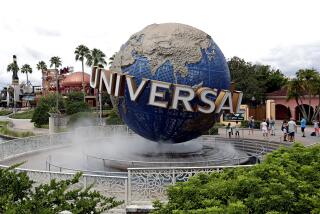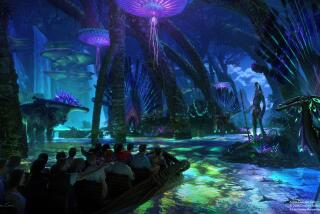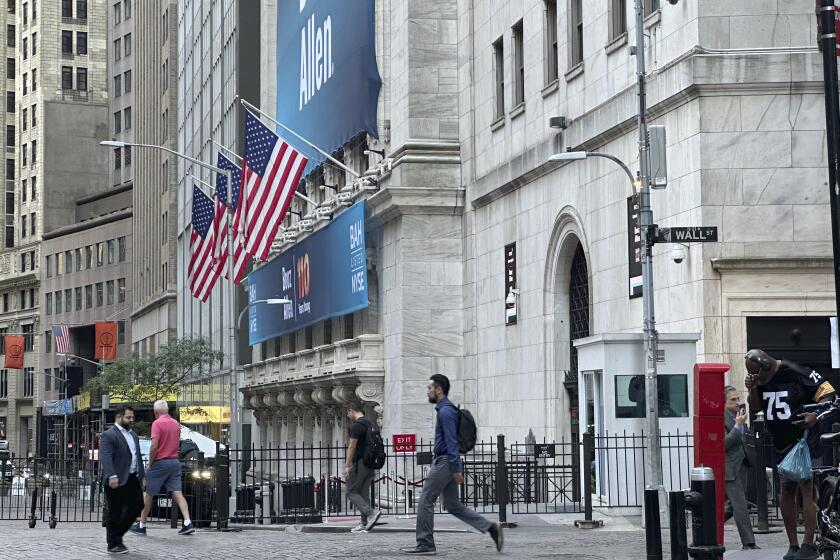Virtual Game Centers: 1; Skeeball: 2
- Share via
The prophets of high technology have for years been predicting that computers would give rise to wholly new forms of entertainment, and thus Walt Disney’s announcement earlier this month that it would launch a chain of regional high-tech entertainment centers had an air of inevitability about it.
Who better than Disney to create elaborate “virtual reality” attractions that use advanced computer graphics and motion simulators to create the illusion of being in, say, a prehistoric world? What other company has so much experience in devising ways for patrons to “enter the story,” as well as a panoply of animated characters that can be readily digitized?
It all seems to make a lot of sense, and perhaps the “Disney-Quest” centers--one will open in Orlando next year, another in Chicago in 1999, and more around the world after that--will be a fabulous success.
Yet I wonder. For one of the great lessons of the digital revolution so far is that creating new forms of entertainment is a lot harder than it looks. Other attempted innovations in what’s known in the trade as “location-based entertainment” have either failed or failed to be anything more than expensive new versions of reliable old ideas.
The most interesting flop, ironically, involves Disney--Tim Disney, that is. The grandnephew of Walt decided a few years ago that he would try to steal a march on the family company with a venture called Virtual World Entertainment, which aimed to build on the success of a pioneering multi-player game called Battletech.
Battletech enabled teams of players to compete against one another in a kind of live-action video game, and the original location in Chicago developed quite a following. Each player sits in his own pod, and the action on the big screen in front of him reflects what those in the other pods are doing.
Virtual World hoped to develop a series of group games and created an elaborate theme--based on the idea of a Victorian-era explorers club--that was supposed to make a visit to Virtual World something more than just a chance to play a game. The company hoped to create leagues of teams and even aimed to spin out the games into other media; they were to involve stories, after all, not simply shoot-’em-ups.
When I visited one of the first Virtual World locations back in 1993, the place was jammed: In bland suburbs like Walnut Creek, east of San Francisco, a little bit of novelty goes a long way. Ultimately, though, the idea just didn’t work. People got tired of playing the same game. It was expensive. All the thematic paraphernalia and storytelling turned out to be irrelevant. Besides, gamers in need of company can now play with others on the Internet.
The company still exists, as does a Virtual World location in Pasadena, but the goal now is to sell Battletech and another game, Red Planet, to other amusement operators.
“We were on a mission from God to proliferate our own idea of what location-based entertainment should be,” says Ted Keenan, vice president for business development at Chicago-based Virtual World. But people wanted a new experience each time.
And, says Keenan, “we and a number of others have been overwhelmed with the sheer size and intensity that some other players have come at this with, these enormous places.”
Specifically, he was referring to Dave & Buster’s, a fast-growing Dallas-based chain commonly described as “Chuck E. Cheese for adults,” and GameWorks, a highly touted joint venture of video game maker Sega, Universal Studios and DreamWorks SKG.
Both now have locations at the Ontario Mills Mall, so I went out to have a look. And about the nicest thing I can say is that I was underwhelmed.
GameWorks is simply a large and expensive arcade with a bar and restaurant attached. Dave & Buster’s is a large bar and restaurant with a pool hall and an arcade attached. That’s it. If there is anything fundamentally new or different about these places, I missed it entirely.
Sure, they do have some especially fancy video games. GameWorks’ Indy 500 lets you compete against eight other racers, and you sit in a little cockpit that jerks around a bit as you zoom along. It’s four bucks a throw. Great.
Another big attraction, Vertical Reality, differs from routine living-room “twitch” games only in that you sit in a seat that lifts you up about 6 feet each time you get to the next level and drops you back down when you get shot. Personally, I’d rather play Asteroids.
Dave & Buster’s has Virtuality, in which players don a headset and control the action with head, hand and foot movements. It’s one of the very few commercial entertainment applications for true-blue virtual reality technology--and it’s been making customers dizzy for about five years now.
Ironically, Dave & Buster’s calls its arcade area the Midway, and in addition to all the indistinguishable fighting and racing games, it has Skeeball and pinball and even that boardwalk classic in which rolling balls into a hole advances your racehorse.
This is all fine, and it may well fill a niche for teenagers who are too young to drink and twentysomethings who don’t like to smoke and boys of all ages who just have to play the coolest new games. Yet I couldn’t help thinking that these places were a step down from the casual, low-brow, low-priced fun of the Santa Monica Pier.
Matters of taste aside, they certainly don’t constitute a new form of entertainment. At best, they simply house the latest incarnation of the video games that revolutionized arcades in the 1970s.
Using technology to create a different kind of entertainment experience has tripped up some pretty capable players. Paramount has been trying for years to develop virtual reality centers based on “Star Trek,” and the project the studio finally launched at the Las Vegas Hilton is said to be behind schedule and over budget.
Iwerks Entertainment, a Burbank-based Disney spinoff, nearly bankrupted itself trying to create virtual reality attractions and venues.
All of which casts the Disney-Quest challenge in sharp relief. Art Levitt, president of the entertainment giant’s newly launched Disney Regional Entertainment subsidiary, discounts comparisons to other ventures. DisneyQuest will be more family-oriented, and it will serve nice food but no liquor, and it will reflect three years of intensive development, much of it in conjunction with technology companies like Silicon Graphics and Tandem Computers.
One attraction, Cyberspace Mountain, will enable visitors to design their own roller coaster using a computer workstation and then take a virtual ride on their creation. Another will allow simulated hand-to-hand combat with Disney villains. There will be nine major attractions, and they’ll be renewed regularly.
It sounds good, original even, and maybe it will be more than a new variation on the venerable amusement park. But the old forms are durable. As Tim Disney and Iwerks and countless Internet and computer software entrepreneurs have discovered, they aren’t supplanted very readily. Walt Disney will definitely have its hands full on this one.
Jonathan Weber ([email protected]) is editor of The Cutting Edge.






